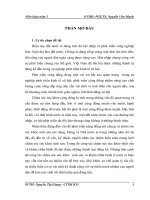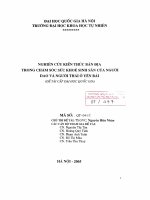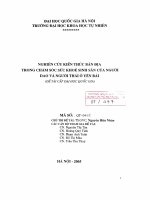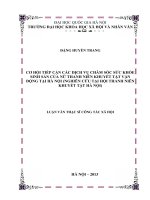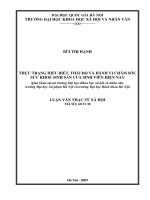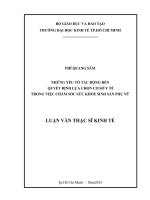Thực trạng công tác chăm sóc sức khỏe sinh sản của nữ công nhân tổng công ty may hưng yên năm 2015
Bạn đang xem bản rút gọn của tài liệu. Xem và tải ngay bản đầy đủ của tài liệu tại đây (814.29 KB, 68 trang )
MINISTRY OF EDUCATION AND TRAININGMINISTRY OF HEALTH
HANOI MEDICAL UNIVERSITY
………***………
NGUYỄN VĂN TOÀN
A SURVEY ON KNOWLEDGE, ATTIUDESAND
PRACTICEREGARDING TO HYPERTENTIONAMONG ELDERLY
PEOPLE IN SELECTED TWO COMMUNESIN BAC GIANG CITY IN
2014
BACHELOR OF SCIENCE NURSING
ADVANCED PROGRAM IN NURSING
2010 – 2014
HANOI – 2015
MINISTRY OF EDUCATION AND TRAININGMINISTRY OF HEALTH
HANOI MEDICAL UNIVERSITY
………***………
NGUYỄN VĂN TOÀN
A SURVEY ON KNOWLEDGE, ATTIUDES AND PRACTICE
REGARDING TO HYPERTENTION AMONG ELDERLY PEOPLE IN
SELECTED TWO COMMUNES IN BAC GIANG CITY IN 2014
BACHELOR OF SCIENCE NURSING
ADVANCED PROGRAM IN NURSING
2010 – 2014
SUPERISOR: MR. BÙI VŨ BÌNH
Master of science in nursing
HANOI– 2015
i
ACKNOWLEDGEMENTS
This study depended on the contribution of many individuals. I am deeply
appreciative of those who offered advice and help. The following individuals
deserve special mention.
First of all, I grateful acknowledge the Presidential Board and the
Undergraduate Training and Management Department of Hanoi Medical
University for giving me the opportunity to complete this thesis.
I would like to express my sincere gratitude to the full support,
unfailing patience, invaluable advice and detailed guidance of Mr. Bui Vu
Binh, Lecturer of the Nursing and Midwifery Department, Hanoi Medical
University, whose comments gave me a clear insight into this study. It was my
privilege to have him as my supervisor.
I would like to acknowledge participants from two ward Dinh Ke and
Hoang Van Thu
for
their
cooperation, willingness
and enthusiasm in
answering the interview that help me to do this thesis better.
Last but not least, from the bottom of my heart, I would like to thank
my dear family
and friends
who always stand by my side, support and
encourage me to complete this thesis.
Hanoi, June 15th, 2015
Nguyen Van Toan
ii
DECLARATION
I declare that this thesis represents my own work, except where due
acknowledgement is made, and that is has not been previously included in a
thesis, dissertation or report submitted to the university or any other institution
for a degree, diploma or other qualifications.
Signed
Nguyen Van Toan
iii
TABLE OF CONTENTS
ACKNOWLEDGEMENTS ................................................................................ i
DECLARATION ............................................................................................... ii
TABLE OF CONTENTS ..................................................................................iii
LIST OF TABLES ............................................................................................ vi
LIST OF FIGURES........................................................................................... vi
LIST OF ABBREVIATIONS .......................................................................... vii
INTRODUCTION.............................................................................................. 1
CHAPTER 1 - LITERATURE REVIEW .......................................................... 3
1.1. Overview of hypertension ....................................................................... 3
1.1.1. Hypertension definition ................................................................... 3
1.1.2. Causes of hypertension .................................................................... 4
1.1.3. Risk Factors...................................................................................... 4
1.1.4. Complications .................................................................................. 4
1.1.5. Management: .................................................................................... 5
1.2. Epidemiology .......................................................................................... 6
1.2.1. Global burden ................................................................................... 6
1.2.2. The prevalence of Hypertension in Vietnam ................................... 7
1.2.3. Hypertension and elderly people with hypertension ....................... 7
1.3. Knowledge, attitude and practice ............................................................ 9
1.3.1. Knowledge, attitude and practice definitions .................................. 9
1.3.2. Knowledge, attitude and practice regarding to Hypertension ....... 10
iv
1.4. Factors influence to healthy blood pressure practice ............................ 13
1.4.1. Educational level ............................................................................ 13
1.4.2. Economical status .......................................................................... 13
1.4.3. Information approach and health care worker-patient relationship
...................................................................................................................... 13
1.4.4. Other factors ................................................................................... 14
1.5. Framework ............................................................................................ 16
CHAPTER 2 - SUBJECTS AND METHOD .................................................. 17
2.1. Study design .......................................................................................... 17
2.2. Sampling and Setting ............................................................................ 17
2.2.1. Setting ............................................................................................ 17
2.2.2. Sampling ........................................................................................ 17
2.2.3. Sample size .................................................................................... 18
2.3. Research instruments ............................................................................ 18
2.4. Research Indicators and Variables ........................................................ 18
2.5. Bias and controllingbias ........................................................................ 19
2.5.1. Acquired bias ................................................................................. 19
2.5.2. Controlling bias .............................................................................. 19
2.6. Research progress ................................................................................. 20
2.6.1. The process of making research ..................................................... 20
2.6.2. Data collection ............................................................................... 20
v
2.6.3. Data analysis .................................................................................. 20
2.7. Ethical considerations ........................................................................... 21
CHAPTER 3 - RESULTS ................................................................................ 22
3.1. General characteristics of the participants ............................................ 22
3.2. Knowledge, attitude and practice related to hypertension care ............ 24
3.2.1. Knowledge of participants on hypertension .................................. 24
3.2.2. Attitudes towards Hypertension ..................................................... 26
3.2.3. Self-care on Hypertension.............................................................. 27
3.3. Factors associated with hypertension.................................................... 29
3.3.1. Participants characteristic and hypertension status ........................ 29
3.3.2. Correlations among Age, Knowledge score, Attitudes score, and
Practice score................................................................................................ 31
3.3.3. Knowledge, attitude, practice with having hypertension............... 32
CHAPTER 4 - DISCUSSION.......................................................................... 34
4.1. General characteristics of the participants ............................................ 34
4.2. Knowledge, attitude, practice of elderly regardingto hypertension ...... 35
4.2.1. Knowledge ..................................................................................... 35
4.2.2. Attitude........................................................................................... 37
4.2.3. Practice ........................................................................................... 37
CONCLUSIONS .............................................................................................. 41
RECOMMENDATIONS ................................................................................. 42
vi
LIST OF TABLES
Table 3.1: Demographic characteristics of the participants ............................. 22
Table 3.2: Hypertension and source of knowledge.......................................... 23
Table 3.3: Knowledge on Hypertension .......................................................... 24
Table 3.4: Attitudes towardsHypertension ...................................................... 26
Table 3.5: Self-care on Hypertension .............................................................. 27
Table 3.6: The relation between gender and hypertension .............................. 29
Table 3.7: The relation between age and hypertension ................................... 29
Table 3.8: The relation between demographic and knowledge ....................... 30
Table 3.9: The relation between demographic and attitudes ........................... 30
Table 3.10: Correlations between age, knowledge score, attitudes score, and
practice score ........................................................................................................ 31
Table 3.11: Knowledge, attitude, practice with hypertension ......................... 32
LIST OF FIGURES
vii
LIST OF ABBREVIATIONS
ACE: Angiotensin-converting enzyme
ARBs: Angiotensin II receptorblockers
A- Score: Attitude score
BP: Blood pressure
CVD: Cardiovascular
DBP: Diastolic Blood Pressure
HBP: High Blood Pressure
HTN: Hypertension
KAP: Knowledge Attitude Practice
K- score: Knowledge score
P-score: practice score
SBP: Systolic Blood Pressure
WHO: World Health Organization
1
INTRODUCTION
Hypertension is an important public health challenge, which affects
approximately one billion people worldwide [1]. According to the World
Health Organization (WHO), hypertension is the leading risk factor for
mortality (12.7% of deaths attributable) [2]. Each year at least 7.1 million
people die as a consequence of hypertension [3].The overall average
prevalence of hypertension in the world was estimated as 35% (37% in men
and 31% in women)[4].
Hypertension has become a significant problem in many developing
countries. In Vietnam the rate of hypertension has increased significantly in
recent years. According to Son Pham (2011), 25.1% of Vietnamese people
(28.3% men vs 23.1% women) over age 25 have high blood pressure. The rate
of hypertension increased with age in both sexes and particularly higher in the
age group over 65[5]. Especially hypertension has serious complications which
are usually found when peoplecheckat the health facilities.
Hypertension is one of the diseases which is more common in old age and
may affect the quality of life in elderly people. According to the studies in the
University of York, hypertension is a risk factor for stroke and ischemic heart
disease in elderly people[6].
With a big concernment about knowledge, attitudes and practices regarding
hypertension among elderly people, the researcher conducted this study in Bac
Giang. Bac Giang is a midland province, 90% of the population live in rural
areas, 10% of poverty. People have less access to health services than other
areas.
The researcher selected study in Bac Giang city. Bac Giang city has 148.172
people, including the elderly accounted for 19.148 persons (12.9%) and 46.5%
2
of people living in urban areas, 53.5% of people living in rural areas.The
researcher conducted this study on 200 participants in some communes of Bac
Giang city in a period from September to November, 2014.
The research did this study with two main objectives:
1. Describe the knowledge, attitude and practices of elderly people regarding
to hypertension.
2. Explorefactors that affect knowledge, attitude and practices of elderly
people regarding to hypertension.
3
CHAPTER 1 - LITERATURE REVIEW
1.1. Overview of hypertension
1.1.1. Hypertension definition
According to the World Health Organization-International Society
of
Hypertension (WHO/ISH) Guidelines for the Management of Hypertension
[7], hypertension is defined as a systolic blood pressure (SBP) of 140 mmHg or
greater and/or a diastolic blood pressure (DBP) of 90 mmHg or greater in
subjects who are not taking antihypertensive medication.For subjects with
diabetes mellitus, end organ damage or metabolic syndrome, blood pressure
levels of130/80 mmHg or greater are defined as hypertension[8, 9].
A classification of blood pressure levels in adults over the age of 18
is provided in Table 1.
Table 1.Definition and classification of blood pressure (diastolic blood
pressure) levels. (According to Vietnam Ministry of Health’s Guidelines for
Prevention and Management of Hypertension)[8]
Category
SBP
DBP
(mmHg)
(mmHg)
Optimal
<120
and
<80
Normal
<130
and/ or
<85
Prehypertension
130-139
and/ or
85-89
Hypertension stage 1 (mild)
140-159
and/ or
90-99
Hypertension stage 2 (moderate)
160-179
and/ or
100-109
Hypertension stage3 (severe)
≥ 180
and/ or
≥ 110
Key: SBP= Systolic blood pressure
DBP= Diastolic blood pressure
4
1.1.2. Causes of hypertension
Primary (essential) hypertension:
For most adults, there's no identifiable cause of high blood pressure. This
type of high blood pressure, called essential hypertension or primary
hypertension, tends to develop gradually over many years.
Secondary hypertension
Some people have high blood pressure caused by an underlying condition.
This type of high blood pressure, called secondary hypertension[10].
Hypertension may be primary, which may develop as a result of
environmental or genetic causes, or secondary, which has multiple etiologies,
including renal, vascular, and endocrine causes. Primary hypertension about
90-95% of adult cases, and secondary hypertension about 2-10% of cases [11].
1.1.3. Risk Factors
According to Mayo clinic high blood pressure has many risk factors,
including: age, race, family history, being overweight or obese, not being
physically active, using tobacco, too much salt (sodium) in diet, too little
potassium in diet, drinking too much alcohol, stress, certain chronic conditions
[11, 12]. Many modifiable factors contribute to the high prevalence rates of
hypertension. They include eating food containing too much salt and fat,
inadequate intake of fruits and vegetables, overweight and obesity, harmful use
of
alcohol,
physical
inactivity,
psychological
stress,
socioeconomic
determinants, and inadequate access to health care. Worldwide, detection,
treatment and control of hypertension are inadequate, owing to weaknesses in
health systems, particularly at the primary care level[13].
1.1.4. Complications
According to Mayo clinic the excessive pressure on your artery walls caused
by high blood pressure can damage your blood vessels, as well as organs in
5
your body. The higher your blood pressure and the longer it goes uncontrolled,
the greater the damage. Uncontrolled high blood pressure can lead to: heart
attack or stroke, aneurysm, heart failure, thickened, narrowed or torn blood
vessels in the eyes, metabolic syndrome, and trouble with memory or
understanding [14].
1.1.5. Management:
If left uncontrolled, hypertension causes stroke, myocardial infarction,
cardiac failure, dementia, renal failure and blindness. There is strong scientific
evidence of the health benefits of lowering blood pressure through populationwide and individual (behavioral and pharmacological) interventions[13].
According to the British Guidelines for HTN 2004, all people with high
blood pressure, borderline or high normal blood pressure should be advised in
lifestyle modifications. People should maintain normal body weight, reduce
salt intake, limit alcohol consumption, and engage in regular aerobic physical
exercise (brisk walking rather than weightlifting) for ≥ 30minutes per day,
ideally on most of days of the week but at least on three days of the week.
Moreover, people should consume at least five portions/day of fresh fruit and
vegetables; and reduce the intake of total and saturated fat.
Most people with high blood pressure will require at least two blood
pressure lowering drugs to achieve the recommended goals[15].Aburto et al.
found that higher potassium intake was associated with a 24% lower risk of
stroke (moderate quality evidence). The results suggest that increased
potassium intake is potentially beneficial to most people without impaired renal
handling of potassium for the prevention and control of elevated blood pressure
and stroke[16].
6
1.2. Epidemiology
1.2.1. Global burden
The overall average prevalence of hypertension in the world was estimated
as 35% (37% in men and 31% in women)[4]. The estimated total number of
adults with hypertension in 2000 was 972 million; 333 million in economically
developed countries and 639 million in economically developing countries.
The number of adults with hypertension in 2025 was predicted to increase by
about 60% to a total of 1.56 billion[17].
According to the Global Status Report on noncommunicable diseases 2014,
the leading causes of NCD deaths in 2012 were: cardiovascular diseases,
cancers, respiratory diseases, including asthma and chronic obstructive
pulmonary disease and diabetes[13]. Globally cardiovascular disease accounts
for approximately 17 million deaths a year, nearly one third of the total. Of
these, complications of hypertension account for 9.4 million worldwide every
year. Hypertension is responsible for at least 45% of deaths due to heart disease
and 51% of death due to stroke as a measure of WHO in 2013[18].
Nearly 80% of deaths due to cardiovascular disease occur in low-and middle
income countries[18]. They are the countries that can least afford the social and
economic consequences of ill health. Current age standardized mortality rates
of low-income countries are higher than those of developed countries.
The economic aspects of hypertension are critical to modem medicine. The
medical, economic, and human costs of untreated and inadequately controlled
hypertension are enormous. Hypertension is distributed unequally and with
iniquity in different countries and regions of the world. Treatment of
hypertension requires an investment over many years to prolong disease-free
quality years of life. The high prevalence and high cost of the disease impacts
on the microeconomics and macroeconomics of countries and regions. The
7
criteria used for inclusion in clinical guidelines for hypertension impact on the
cost and cost/utility of diagnosis or treatment.
1.2.2. The prevalence of Hypertension in Vietnam
Pham Thai Son in a national survey in Vietnam in 2013 found that the
prevalence of hypertension was high (overall 25.1%, 28.3% in men and 23.1%
in women). The proportions of hypertensive aware, treated and controlled were
unacceptably low (48.4%, 29.6% and 10.7% respectively).
According to Do Thi Phuong (2013), the overall prevalence of hypertension
among total 18,000 participants was 21% and 42% of the people had
prehypertension, only 37% had normal blood pressure[19].
The increasing prevalence of hypertension is attributed to population
growth, ageing and behavioral risk factors, such as unhealthy diet, harmful use
of alcohol, lack of physical activity, excess weight and expose to persistent
stress.
1.2.3. Hypertension and elderly people with hypertension
Hypertension is the most important risk factor of cardiovascular and kidney
diseases; and a leading risk factor for mortality[20]. Hypertension has become
a significant problem in many developing countries. In 2008, nearly a billion
adults aged 25 years and older had hypertension, and three quarters of the
number were living in developing countries[21]. However, despite such high
prevalence awareness and blood pressure control are fairly poor in developing
countries as a result of inadequate access to information, healthcare facilities,
inappropriate dietary habits, poverty and high cost of medications[22].
In Vietnam, hypertension has become an important public health problem.
The rate of hypertension has increased significantly in recent years. According
to Son Pham (2011), 25.1% of Vietnamese people (28.3% men vs. 23.1%
women) over age 25 have high blood pressure. The rate of hypertension
8
increased with age[5]. The level of awareness and efforts to control of
hypertension remains relatively low[5, 23] . A recent national survey found
that among hypertensive people only a half (48.4%) were aware of their high
blood pressure and only a third (29.6%) were undertaking treatment.In
addition, only a third of the patients undertaking treatment had their blood
pressure controlled[5].
Hypertension is one of the major health problems among elderly
people has been investigated by many Vietnam authors. Vietnam Institute
of Health Strategy and Policy presented a hypertension percentage of 28,4%
among elderly people of aged 60 years or above in 2006[24].Hypertension is
one of the diseases which is more common in old age and may affect the
quality of life in elderly people. According to the studies in the University of
York, hypertension is a risk factor for stroke and ischemic heart disease in
elderly people[6]. Data collected over a 30-year period have demonstrated
the increasing prevalence of hypertension with age. The risk of coronary
artery disease,
insufficiency
stroke,
and
congestive
dementia
is
also
heart
disease,
increased
in this
chronic kidney
subgroup
of
hypertensive[25]. Cardiovascular disease (CVD) was the leading cause of
death in adults. One major reason for this trendies the patterns of BP changes
and increasing hypertension prevalence with age approximately 1 billion
people worldwide)[20]. Hypertension prevalence is less in women than in men
until 45 years of age,similar in both sexes from 45 to 64 and much higher in
womenthan men over 65 years of age[26]. The severity of hypertension related
to the age of the woman. After 60 years the majority of women have high
blood pressure or treatment of blood pressure control. Further blood pressure
control is often difficult in elderly women[27].
9
There are many risk factors that can lead to high blood pressure in the
elderly, such as diabetes, tobacco addiction, alcoholism, obesity or metabolic
disorders ofblood fat, atherosclerosis circuit. In addition, hypertension can be
caused byheredity, sedentary habits are vegetarians or have an adverse effect
on the psychological(stress).
Symptoms of hypertension were very poor, even several elderly people with
hypertension but do not know because there is not anything unusual
manifestations.
1.3. Knowledge, attitude and practice
1.3.1. Knowledge, attitude and practice definitions
Knowledge definition: Knowledge is a set of understandings, knowledge
and of “science.” It is also one’s capacity for imagining, one’s way of
perceiving. Knowledge of a health behavior considered to be beneficial,
however, does not automatically mean that this behavior will be followed. The
degree of knowledge assessed by the survey helps to locate areas where
information and education efforts remain to be exerted.
For example: Hypertension is an acute disease? Yes/ No/ don’t know
Attitude definition: Attitude is a way of being, a position. These are leanings or
“tendencies to…”. This is an intermediate variable between the situation and
the response to this situation. It helps explain that among the possible practices
for a subject submitted to a stimulus, that subject adopts one practice and not
another. Attitudes are not directly observable as are practices, thus it is a good
idea to assess them. It is interesting to note that numerous studies have often
shown a low and sometimes no connection between attitude and practices.
For example:Smoking and drinking alcohol have little effect on blood pressure.
Agree/ Uncertain/ Disagree.
10
Practice definition: Practices or behaviors are the observable actions of an
individual in response to a stimulus. This is something that deals with the
concrete, with actions. For practices related to health, one collects information
on consumption of tobacco or alcohol, the practice of screening, vaccination
practices, sporting activities, sexuality etc.
For example: Do you smoke? Yes/ No[28]
1.3.2. Knowledge, attitude and practice regarding to Hypertension
The main reasons for this inadequate control of blood pressure include
demographic characteristics, health beliefs and the presence of other chronic
diseases. Other reasons include lack of hypertension awareness and lack of
knowledge about high blood pressure. While it is difficult or impossible to
change demographic and personal characteristics, cultural norms and
socioeconomic status, increasing knowledge through educational interventions
on treatment can positively.Because hypertension is emerging as a major
public health problem in many developing countries, KAP data on
hypertension as crucial steps in the design of sound prevention and control
programs. It is particularly important to maximize the efficiency of such
programs in these countries to minimize delay in achieving effective
hypertension control[29].In a descriptive survey by Oliviera et al (2005) [30] to
understand the current status of hypertension knowledge, awareness, and
attitudes in a group of hypertensive patients, results showed that patients are
knowledgeable about hypertension in general, but are less knowledgeable
about specific factors related to their condition. According to a cross-sectional
study assessed knowledge, attitude and practice of exercise for blood pressure
control among 20 years and older Nigerian patients with hypertension in 2013;
more than half of the respondents, (60.0%) demonstrated poor exercise
practice. A majority, 67.3% had poor knowledge of exercise for hypertension
11
control while a quarter, 26.0% had positive attitude towards exercise. There
were significant associations between knowledge of exercise and level of
education, attitude and practice of exercise,respectively. Significant association
was found between knowledge and each of socio-economic status and attitude.
Practice of exercise for blood pressure control was low among Nigerian
patients with hypertension which was significantly influenced by poor
knowledge of and negative attitude towards exercise practice for blood
pressure control[31].
Also conducted in Nigerian in 2010, the study of Godfrey indicated that 61%
respondents knew HTN to be high blood pressure, 20% thought it meant
excessive thinking and worrying while 53% claimed it was hereditary. 40%
participants felt it was caused by malevolent spirits, 30% believed it was
caused by bad food or poisoning. A few (18%) knew some risk factors.
Symptoms attributed to HTN were headache, restlessness, palpitation,
excessive pulsation of the superficial temporal artery and “internal heat”, but
74% attested to its correct diagnosis by BP measurement. Although 90.7% felt
the disease indicated serious morbidity, only 33.3% were adherent with
treatment and fewer practiced life-style modification. 30% knew at least one
antihypertensive drug they use. Psychosocial factors like depression and
anxiety, fear of addiction and intolerable drug adverse effects impacted
negatively on patients’ attitude to treatment[32].
In Vietnam, Pham Thai Son in 2012 found that the proportions of
hypertensive aware, treated and controlled were unacceptably low (48.4%,
29.6% and 10.7% respectively). Most Vietnamese adults (82.4%) had good
knowledge about high blood pressure. People received their information on
hypertension from mass media (newspapers, radio, and especially television).
Most people would choose a commune health station (75%) if seeking health
12
care for hypertension. The programmer on hypertension control was able to run
independently at the commune health station. Severity of hypertension and
effectiveness of treatment were the main factors influencing people’s
adherence to the programmer. The hypertension control programmer
successfully reduced blood pressure (systolic blood pressure: -2.2 mmHg in
men and -7.8 mmHg in women; diastolic blood pressure: -4.3 mmHg in men
and -6.8 mmHg in women), the estimated CVD 10- year risk (-2.5% in
women), and increased the proportions of treatment (22% in men and 13.6% in
women) and control (11% in men and 17.3% in women) among hypertensive
people[33].
Assessment for KAP score often based on questionnaires available has been
verified in previous studies or based on questionnaires developed based on the
old question. Depending on the different questions the author will have
different score. For example, according to research by the author Olusegun
Adesola Busari el al have the following scoring method: “Patients’ knowledge,
attitudes and practices on HTN were assessed using a standardized and
structured questionnaire which was developed and pre-tested for the study.It
had both closed and open-ended questions.Consent was obtained after the
purpose of the study was adequately explained to therespondents. The
questionnaire covered sociodemographic, occupational and educational
variables, information on knowledge of HT and its treatment, attitude
toward. Closed ended questions often included three or more answering
options in addition to the option “I do not know”, which was a possible option
for many questions. Answering option, “No” was always preceding option,
“Yes”. Responses to the questions on knowledge were scored. The total score
obtainable was 12 and any score less than 7 was described as poor
knowledge”[29].
13
1.4. Factors influence to healthy blood pressure practice
There are a lot of factors affecting K-A-P regarding hypertension among
elderly people. In this chapter, the researcher specifically concerns about the
Demographic factors.
1.4.1. Educational level
The level of education can have a large impact on the people’s ability of
absorption, especially elderly people.
A study of Tran Thien Thuan in Ho Chi Minh City in 2006 demonstrated
that lower level of education can lead to lower Knowledge score[34].
Mumtaz A.S. in a study in Adult Hypertensive patients found that educated
people had better understanding of hypertension than patients who were less
educated. More detail, educated people were able to understand the
complications of BP more effectively. It has been observed that more educated
patients were able to report that they had received information regarding ideal
Blood pressure values compared to less educated patient[35].
1.4.2. Economical status
Lower socio-economical status can lead to poorer knowledge, negative
attitudes and ineffective practice regarding HTN. A cross-sectional survey in
Nigerian found a significant association between each of socio-economic status
and knowledge (χ2=19.192; p=0.001)[36]. Similarly, Tran Thien Thuan found
that low income was a reason for negative attitudes and wrong practice
amongst HTN adult patient[34].
1.4.3. Information approach and health care worker-patient relationship
According to a survey of under-graduated students in Hue, most people
found information about HTN from their relatives and friends (80.7%), whilst
that from television was 67.7%. However, there were 48.5% found information
14
through health propagandas and health care workers and only 6.2% through
local radiocast.
In another study of Mumtaz, 10% patients reported that a physician or other
health care provider was a source of information about HTN; 6% found
information from television, newspapers, magazines and radio[35].
Health care providers and health propaganda play a very important role in
enhancing the HTN knowledge of people, especially in rural and remote areas.
Besides methods of approaching information, the relationship between
health care providers, especially doctor and patient also affect to their KAP.
Tran Thien Thuan has reported that one of the reasons why people had
ineffective practice regarding HTN was the difficulty of and irregular health
examination in local health care units. Mumtaz also indicated that the better
doctor-patient relationship having, the more effective in providing good control
of blood pressure provide. Greeff in 2006 emphasized that building a trusting
relationship between the health care worker and the patients is one of the most
important aspects when motivation patient[37].
1.4.4. Other factors
In researcher’s opinion, the age of patients can have an impact on the ability
of knowledge absorption, attitudes and effective practice regarding HTN.
When people get older, they may become more conservative. Furthermore,
many first-stage symptoms and complication of HTN can be skipped because
of the confusion between them and the normal degeneration of age.
Last but not least, there is a close relationship between the three factors:
knowledge, attitudes and practice regarding HTN. The cross-sectional study in
Nigerian indicated a significant relationship between knowledge and attitude
(χ2=25.634; p=0.001); practice of exercise for blood pressure control was
significantly influenced by poor knowledge of and attitude towards exercise
15
practice for BP control[36]. Tran Thien Thuan’s study had similarly findings
when poor and wrong knowledge was a reason of negative attitude and wrong
practice among patients.
16
1.5. Framework
Demographic
Knowledge
Attitude
Practice
Hypertension

